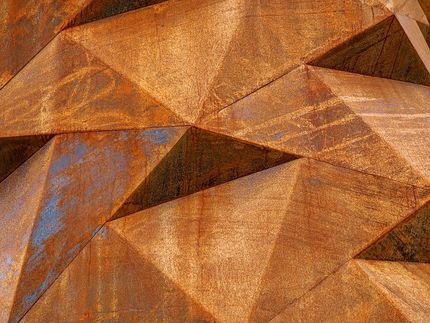New research shows why metal alloys degrade
Metal alloys can fail unexpectedly in a wide range of applications - from jet engines to satellites to cell phones - and new research from the University of Michigan helps to explain why. Metal alloys are solids made from at least two different metallic elements. The elements are often mixed together as liquid, and when they "freeze," into solids, tiny grains of crystal form to create a polycrystalline material. A polycrystalline material is made of multiple crystals.
Within each of the grains of crystal, atoms are arranged in a periodic pattern. This pattern isn't perfect, though. For example, some of the places atoms should be are empty. These empty spaces are called vacancies. Atoms of each element in the alloy take advantage of these holes in the lattice. In a process called diffusion, atoms hop through the material, changing its structure.
"It's kind of like musical chairs," said Katsuyo Thornton, assistant professor in the U-M Department of Materials Science and Engineering. "Diffusion happens in nearly every material, and materials can degrade because diffusion causes certain changes in the structure of the material."
Atoms of different elements tend to hop at different rates because they are bound to their surrounding atoms with varying strength. Thornton and her colleagues have demonstrated that when there's a greater discrepancy in the hop rates in the different elements in the alloy, there's a more pronounced diffusion along grain boundaries. This possibly leads to a faster degradation. Thornton's collaborators on this project are Materials Science and Engineering doctoral student Hui-Chia Yu, and Anton Van der Ven, an assistant professor in the same department.
"In some cases, the grain-boundary diffusion is 100 times higher than what was commonly expected," Thornton said. "This is a very generic finding. That's why it's important. It applies to a wide variety of materials. It applies to polycrystalline materials including electronic materials like solder."
Conventional solder, made of tin and lead, is a common alloy that connects electronic components in computer circuit boards and gadgets. Because lead is toxic, engineers are working to design new kinds of solder without lead. But they haven't found a substitute that works as well. The team's findings may help explain why "tin whiskers" form in some of these new solders. Tin whiskers have caused damage to satellites, for example.
"We are trying to apply this theory to whisker growth in solder," Thornton said.
This finding suggests that materials scientists could make longer-lasting alloys if they use metals with similar atomic hop rates, or manipulate the intrinsic hop rates by other mechanisms.
Original publication: "Theory of grain boundary diffusion induced by the Kirkendall effect"; Applied Physics Letters 2008.
Most read news
Other news from the department science

Get the chemical industry in your inbox
By submitting this form you agree that LUMITOS AG will send you the newsletter(s) selected above by email. Your data will not be passed on to third parties. Your data will be stored and processed in accordance with our data protection regulations. LUMITOS may contact you by email for the purpose of advertising or market and opinion surveys. You can revoke your consent at any time without giving reasons to LUMITOS AG, Ernst-Augustin-Str. 2, 12489 Berlin, Germany or by e-mail at revoke@lumitos.com with effect for the future. In addition, each email contains a link to unsubscribe from the corresponding newsletter.




























































